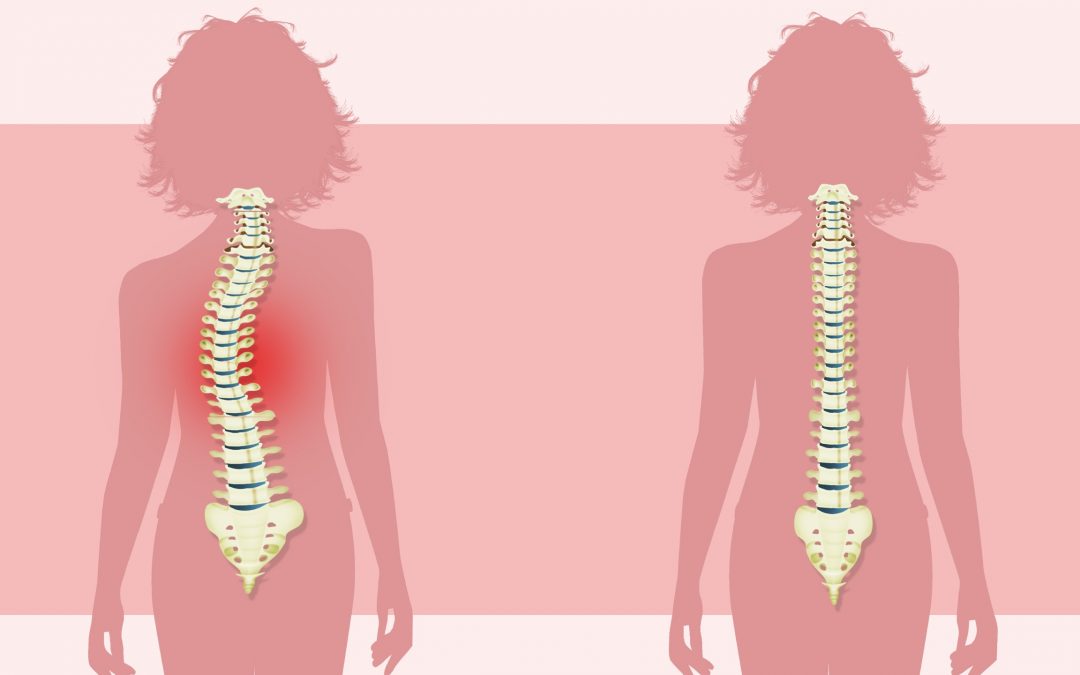Odds are that you know someone who has been diagnosed with a scoliosis, or maybe you are someone who’s had a diagnosis of scoliosis. What does scoliosis actually mean? Is scoliosis something you can expect to improve as time goes on or should you seek treatment for it? If so, who should you speak to? These are some of the questions I hope to answer so that you can be empowered when deciding how to approach scoliosis.
Let’s start off by talking about what a scoliosis actually is, beyond the scary sounding medical jargon. Viewed from the front, a healthy spine should appear straight and from the side, the spine should have 4 smooth curves. A scoliosis is essentially a structural change in the shape of the spine where a sideways curve of the spine becomes evident from the front, whether visible on external examination or on X-ray.
Scoliosis can vary in onset from congenital scoliosis, meaning from birth, to adult scoliosis, which is a curve developing after 18 but most often it becomes evident around a growth spurt or just before puberty. Scoliosis also ranges in severity, with a curve between 0-25 degrees being classified as mild, 25-40 degrees as moderate and 40+ degrees severe. Someone with a scoliosis of 50 degrees or more will generally have a visible deformity with limited function and surgery is often indicated.
For the sake of this discussion we will break scoliosis into two main types:
Structural scoliosis is the most common type and is the result of the misalignment of the bones and joints of the spine as the result of physical, chemical or emotional stress during development or throughout life. In some cases there can even be changes in the shape of the bones of the spine.
Neuromuscular scoliosis is a curve in the spine caused by altered nerve function affecting the muscles on either side of the spine creating asymmetrical pulling forces.
Symptoms of scoliosis can vary greatly since it affects the structure of the spine, which houses the spinal cord. The spinal cord is a bundle of nerve fibers that acts like a fiber cable connecting the brain and body. When the structure of the spine is altered it can cause interference in the communication between the brain and body, meaning that symptoms can vary greatly. Any process in the body which the brain controls can be affected by irritation to the spinal cord. From the most common symptoms, such as back pain, pelvic pain and general muscle stiffness to shortness of breath, migraines and even numbness in the legs and feet. It’s also important to note that scoliosis may have no symptoms at all. It is abundantly clear that the severity of symptoms has a poor correlation to the severity of the scoliosis on X-ray.
A scoliosis can be diagnosed by physical examination or by imaging.
In a physical examination for scoliosis, the doctor will ask you to stand with your arms at your side and visually examine your shoulders and pelvis for symmetry, they may also run their hand down your spine to feel the shape. They will then ask you to bend forward to assess for any asymmetry of the ribs or worsening of any curves found in the spine.
Imaging for scoliosis will most commonly be in the form of an X-ray but may also be in the form of a CT-scan, bone scan or rarely, an MRI.
When do I seek help for scoliosis?
Earlier I mentioned the four normal curves of the spine when viewed from the side, it is worth noting that it is very uncommon to find a scoliosis that is not combined with some alteration in one or more of these curves.
Changes in these curves are strongly linked to interference in the way the brain communicates with the body. They can place stress on the nervous system, creating an environment of dis-ease and that is one reason why scoliosis can become a health concern rather than a back complaint.
Another health issue linked to severe forms of scoliosis is the pressure they can cause on the internal organs like the heart and lungs which is why early detection and management is recommended.
Where do I seek help for scoliosis?
Since scoliosis may not display any symptoms it is important to have your spine examined regularly by a trained healthcare provider, the same way you get your teeth checked annually by a dentist.
Chiropractors are specifically trained in the assessment of the spine and nervous system and as such are well placed to assess your spine for scoliosis. Chiropractors are primary health-care providers, meaning you don’t need a referral from your doctor to see one.
A Chiropractor who does structural correction can play a role in the management of even the most severe cases of scoliosis, delivering gentle adjustments to the spine to restore the alignment and function of the bones and joints, relieving spinal cord irritation and clearing interference in the communication between your brain and body. These adjustments help restore ease in your muscles, spine and nervous system.
Additional treatment of scoliosis with other healthcare professionals like physiotherapists and medical doctors may be useful. Treatment may take the form of exercises, medication to help manage pain sometimes associated with scoliosis, bracing in moderate to severe cases and in very severe cases, surgical fusion of the effected segments to prevent worsening of the curve may be indicated.
Early detection and management by a Chiropractor is strongly recommended to help find and address scoliosis.
Peak Chiropractic Centre located in Claremont are family-friendly chiropractors focused on relieving aches, pains and posture correction. We offer in-house X-Ray facilities.

